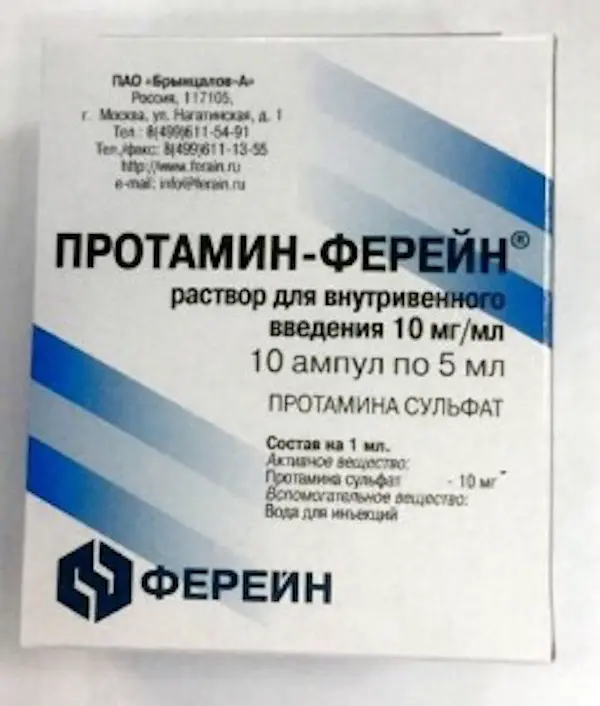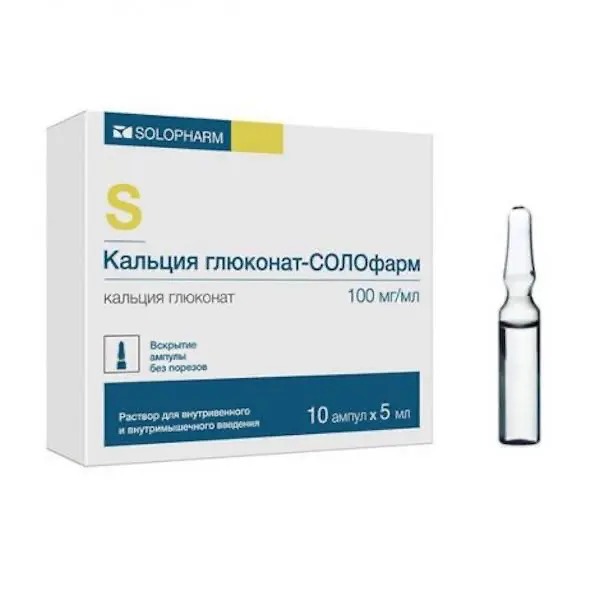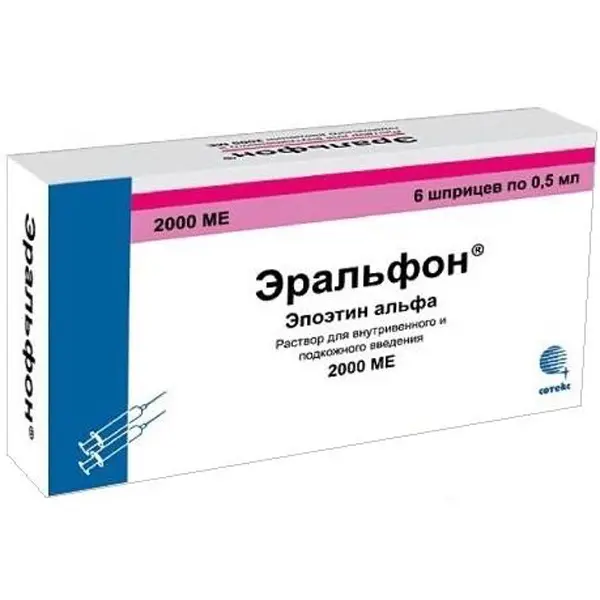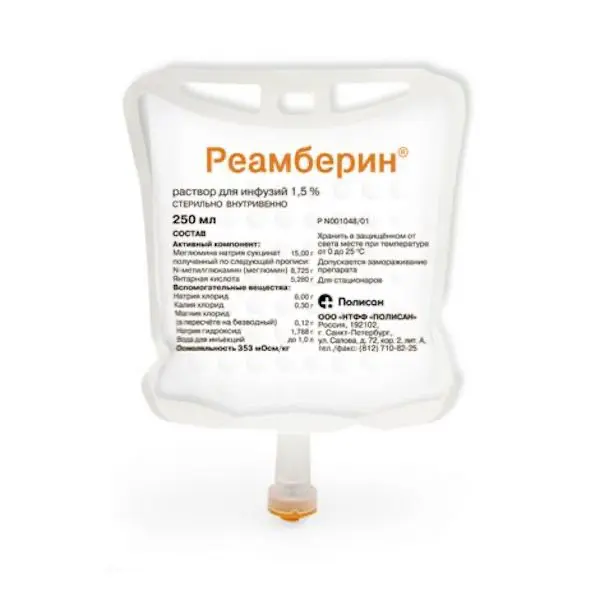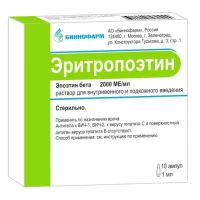Description
Protamine-Ferein Pharmacodynamics
Heparin antagonist. Inactivates heparin through electrostatic interaction with it.
Protamine is a peptide obtained from the mature testes of various fish in the form of sulfate or chloride, and is used to neutralize the anti-clotting effect of heparin. About 67% of the amino acid composition of protamine is arginine, which makes it a strongly alkaline polycationic substance with a molecular weight of 4,500 Da. Multiple positively charged chains of protamine are connected to negatively charged DNA groups.
In vitro, when heparin is added to protamine, a stable precipitate is formed due to ionic interactions. The protamine molecule contains two active centers, one of which neutralizes heparin, and the other has moderate anticoagulant activity independent of heparin. The activity of the drug is determined biologically by the ability to neutralize the anticoagulant effect of heparin on bovine or sheep plasma in vitro, in the presence of excess calcium chloride. Activity is expressed in units of action (units). A 1 ml solution of the drug should contain at least 750 units. 1 mg (75 U) of protamine sulfate neutralizes about 85 U of sodium heparin.
It is effective for some types of hemorrhages associated with heparin-like clotting disorders.
Although the drug is considered a heparin antagonist, in high doses it is able to exert anticoagulatory effect itself, which is sometimes mistakenly assessed as a result of insufficient heparin neutralization.
Indications
– Bleeding caused by heparin overdose;
– Before surgery in patients who take heparin for therapeutic purposes;
– After operations on the heart and blood vessels with extracorporeal circulation;
– hyperheparinemia.
Contraindications .
– Hypersensitivity to the components of the drug;
– Idiopathic or congenital hyperheparinemia (in such cases the drug is ineffective and may increase bleeding);
– severe arterial hypotension;
– thrombocytopenia;
– insufficiency of the adrenal cortex;
– Patients taking insulin containing protamine sulfate, as well as other drugs containing protamine sulfate;
– history of allergic reactions to fish.
There is limited experience with medical use in children.
Dosage and administration method
- Intravenously by slow trickle or drip under control of blood clotting.
- In case of heparin overdose, heparin is injected with 1 ml (10 mg) of protamine sulfate solution by jetting for 2 min. If necessary, injections are repeated at 15-30 min intervals, the total dose is usually 5 ml (50 mg) of the solution.
- The maximum dose is 150 mg/h.
- In case of bleeding, the daily dose is 5-8 mg/kg; intravenous drops are administered in 2 injections at 6-hour intervals.
- The drug dose depends on the method of heparin administration. The calculated dose of the drug is dissolved in 300-500 ml of 0.9% sodium chloride solution.
- During bolus injections of heparin, the dose of protamine sulfate decreases depending on the time elapsed from the introduction of heparin, as the latter is continuously removed from the body.
- Time elapsed after
- Heparin injection The dose of protamine sulfate
- per 100 ME of heparin
- 15-30 minutes 1.2-1.3 mg
- 30-60 minutes 0.5-0.75 mg
- Over 2 hours 0.25-0.375 mg
- 2. If heparin was administered by intravenous drip, stop its infusion and administer 25-30 mg of protamine sulfate.
- 3. For subcutaneous and intramuscular heparin injections, the dose of protamine sulfate is 1.2-1.3 mg for every 100 ME of heparin.
- The first 25-50 mg of protamine sulfate should be administered slowly intravenously, and the remaining dose should be given by intravenous drip for 8-16 hours. Fractional administration of protamine sulfate is possible and requires monitoring of activated partial thromboplastin time (APT). For example, if 20000 ME heparin is administered subcutaneously, heparin resorption occurs after 2 hours, from complexes with protamine at 3333 ME heparin, therefore the next dose of protamine sulfate is 33 mg.
- 4. If extracorporeal circulation is used during surgical intervention, the dose of protamine sulfate is 1.2-1.3 mg for every 100 ME of heparin. When determining the dose of protamine, the route of heparin administration should be taken into account.
- Maximum duration of treatment is 3 days.
- In case of heparinemia associated with extracorporeal circulation, the dose of the drug can be increased; in these cases the solution is administered by drip. Protamine sulfate is used for neutralization of low molecular weight heparins (LMWH), but it is not able to fully eliminate their antithrombotic activity: 1 mg of protamine sulfate neutralizes 100 units of anti-IIa activity and no more than 60% of anti-Xa activity of low molecular weight heparins. When choosing the dose of protamine sulfate, it is necessary to take into account the amount of low molecular weight heparin injected, the route of its administration, peculiarities of the pharmacokinetics of the drug used, as well as the time that has passed since the last injection of low molecular weight heparin.
- Protamine sulfate is administered intravenously slowly (1 mg protamine sulfate per 100 anti-Xa ME of newly injected low molecular weight heparin) or as an infusion. A half dose of protamine sulfate can be used 8 h after intravenous low-molecular-weight heparin drip administration; after 12 h protamine sulfate is probably not required. Prolonged maintenance of the effect of low molecular weight heparin continuing to come from the subcutaneous tissue makes infusion of a calculated dose of protamine sulfate for several hours or reintroduction of a half dose if bleeding persists justified.
- Patients with renal and hepatic impairment
- In patients with mild to moderate renal insufficiency (CKD > 30 ml/min and < 60 ml/min) the dose should not be reduced, in patients with severe renal insufficiency (CKD < 30 ml/min) the dose should be reduced by 25%.
- Use with caution in patients with hepatic impairment.
- Elderly patients
- No dose adjustment is required in elderly patients (except in patients with renal impairment).
- Use in pediatrics
- Safety and efficacy of protamine sulfate application in children have not been studied, therefore the drug is not used in this category of patients. There are no data on the use of the drug in children.

